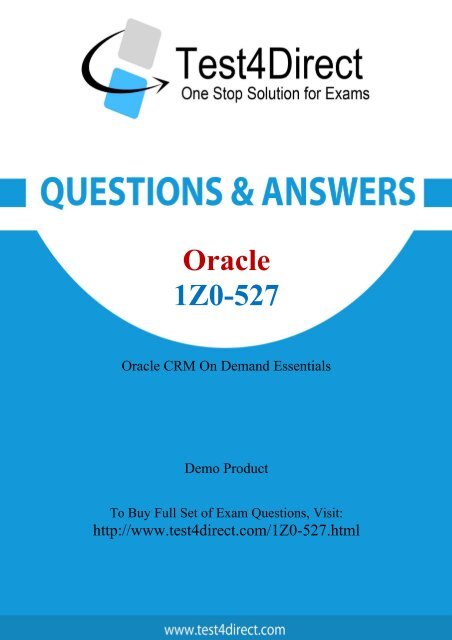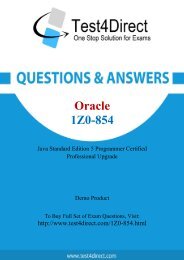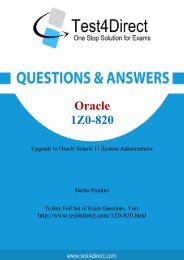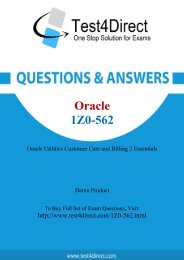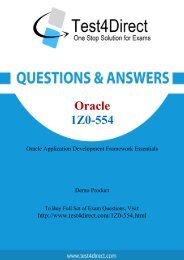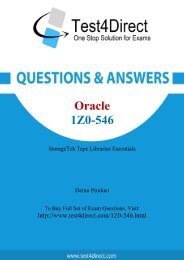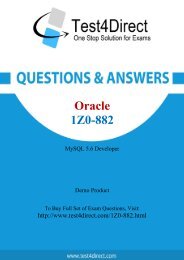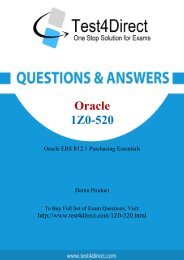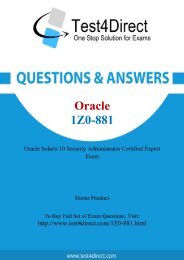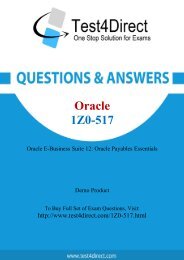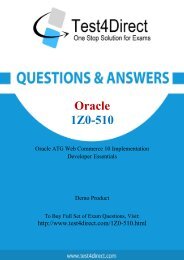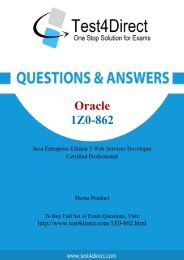Up-to-Date 1Z0-527 Exam BrainDumps for Guaranteed Success
Test4Direct provides latest PDF questions of Oracle 1Z0-527 exam. You have an opportunity to pass the Oracle 1Z0-527 exam in one go. Test4Direct is most accurate source to prepare Oracle 1Z0-527 exam as your success will become site’s responsibility after purchasing 1Z0-527 exam product. There are also lots of discounts and promotion offers that you can avail. Let’s try a free demo http://www.test4direct.com/1Z0-527.html
Test4Direct provides latest PDF questions of Oracle 1Z0-527 exam. You have an opportunity to pass the Oracle 1Z0-527 exam in one go. Test4Direct is most accurate source to prepare Oracle 1Z0-527 exam as your success will become site’s responsibility after purchasing 1Z0-527 exam product. There are also lots of discounts and promotion offers that you can avail. Let’s try a free demo http://www.test4direct.com/1Z0-527.html
You also want an ePaper? Increase the reach of your titles
YUMPU automatically turns print PDFs into web optimized ePapers that Google loves.
Oracle<br />
<strong>1Z0</strong>-<strong>527</strong><br />
Oracle CRM On Demand Essentials<br />
Demo Product<br />
To Buy Full Set of <strong>Exam</strong> Questions, Visit:<br />
http://www.test4direct.com/<strong>1Z0</strong>-<strong>527</strong>.html
Question: 1<br />
You have a requirement <strong>to</strong> set up an Expenses object. This object will be used often by marketing and<br />
sales users and you need <strong>to</strong> create a set of lists <strong>to</strong> appear on their Expenses home pages. The<br />
marketing users will want lists that search on an Expense Category pick list field and the sales users<br />
will want lists that search on an Expense <strong>Date</strong> field. You decided you will use a Cus<strong>to</strong>m Object <strong>for</strong> the<br />
Expenses object. What recommended best practice should you keep in mind when setting up the<br />
fields <strong>for</strong> the new Expenses object?<br />
A. Create a new Expense <strong>Date</strong> field with a Field Type of <strong>Date</strong>/Time so that your lists can query<br />
correctly <strong>for</strong> different locales.<br />
B. Select the Required check boxes at the field level <strong>for</strong> both the Expense <strong>Date</strong> and Expense Category<br />
fields so all users have <strong>to</strong> fill in these values.<br />
C. Rename indexed fields <strong>to</strong> use <strong>for</strong> the Expense <strong>Date</strong> and Expense Category fields so your lists run<br />
faster.<br />
D. Deselect the copy enabled check box <strong>for</strong> the expense date and expense category fields so your lists<br />
run faster.<br />
Explanation:<br />
A <strong>Date</strong> Field is required.<br />
Question: 2<br />
Answer: A<br />
Once a <strong>for</strong>ecast is set up, it typically does not need <strong>to</strong> be updated unless certain events take place<br />
which two events may require an update of the <strong>for</strong>ecast definition?<br />
A. Creating a new <strong>for</strong>ecast report In Analytics<br />
B. Creating a new access profile <strong>for</strong> a role including in the <strong>for</strong>ecast<br />
C. Deactivating employees with the roles Included In the <strong>for</strong>ecast<br />
D. Changing the expiration date of the <strong>for</strong>ecast alert message<br />
E. Changing the reporting structure<br />
Answer: B, C<br />
Explanation:<br />
After you set up your <strong>for</strong>ecast definition, certain changes that you make <strong>to</strong> user records will<br />
require you <strong>to</strong> update your <strong>for</strong>ecast definition settings.<br />
You must update your <strong>for</strong>ecast definition settings after you make the following changes <strong>to</strong> user<br />
* Adding or removing employees from the roles included in the <strong>for</strong>ecast (B). If you add or remove<br />
employees from employees from the roles that are included in the <strong>for</strong>ecast, you must update the<br />
<strong>for</strong>ecast definition settings.<br />
* Deactivating users who are participants in the <strong>for</strong>ecast hierarchy (C). When an employee leaves<br />
your company, you must change the status <strong>for</strong> that user <strong>to</strong> Inactive. If the inactive employee was a<br />
<strong>for</strong>ecast participant, the Reports To field <strong>for</strong> any <strong>for</strong>ecast users reporting <strong>to</strong> that employee must also
e updated, unless you select the option <strong>to</strong> allow <strong>for</strong>ecasts <strong>for</strong> inactive users. If you assign users <strong>to</strong> a<br />
new manager when you make a <strong>for</strong>mer manager inactive, make sure that the new manager's role is<br />
also included as part of the <strong>for</strong>ecast definition.<br />
* Changing the name in the Reports To field in a participant's user details. When you change the<br />
name in a participant's Reports To field, make sure that the new manager's role is also included in<br />
the <strong>for</strong>ecast definition. The <strong>for</strong>ecast participant hierarchy must include managers <strong>for</strong> everyone except<br />
the person at the <strong>to</strong>p level. If the role assigned <strong>to</strong> the new manager is not one that is currently<br />
included in the <strong>for</strong>ecast definition, add it in Step 3 of the setup wizard.<br />
Question: 3<br />
A company wants <strong>to</strong> implement a policy that employees should only use the CRM on Demand<br />
application when they are in the company office. What is the best way <strong>to</strong> implement this policy in<br />
the application?<br />
A. Navigate <strong>to</strong> the Company Profile page and change the company Authentication Type <strong>to</strong> Single-Sign<br />
on Only.<br />
B. Moni<strong>to</strong>r the Sign-In Audit <strong>to</strong> identify users that do not con<strong>for</strong>m <strong>to</strong> the policy and Inactivate their<br />
user credentials.<br />
C. Use the Company Administration > Security Settings page <strong>to</strong> enter the specific IP address ranges<br />
<strong>for</strong> the company network.<br />
D. Change the sign-in page <strong>for</strong> user authentications <strong>to</strong> a page behind the company firewall.<br />
Question: 4<br />
Answer: C<br />
Explanation:<br />
The Restricting Use <strong>to</strong> IP Addresses feature allows your company <strong>to</strong> restrict access <strong>to</strong> the system <strong>to</strong><br />
specific IP address ranges. You can use this feature <strong>to</strong> ensure that your users only access the system<br />
from specific network locations, such as your office. If this feature is enabled, your users can only<br />
sign in <strong>to</strong> the application from machines that have IP addresses within the range you specified.<br />
You created an Account Assignment Rule and added users <strong>to</strong> the Team Assignment section on the<br />
Rule Detail page. When the rule is triggered and an Account record is assigned, which two actions<br />
occur?<br />
A. All users on the team are given the same access level as the assigned record owner <strong>to</strong> the<br />
Account, and Its related Contact and Opportunity records.<br />
B. All users on the team are also assigned <strong>to</strong> the terri<strong>to</strong>ry specified in the Assign To Terri<strong>to</strong>ry field <strong>for</strong><br />
the rule.<br />
C. Unless you selected the Include Team Assignment check box <strong>for</strong> the rule, no users are assigned <strong>to</strong><br />
the team.<br />
D. Only the users that meet the rule criteria are assigned <strong>to</strong> the team.<br />
E. Each user on the team is given the specified access level <strong>to</strong> the Account, and its related Contact<br />
and Opportunity records.<br />
Explanation:<br />
Answer: A
Account records are central <strong>to</strong> how you manage and view your data. As a result, you should enter as<br />
much in<strong>for</strong>mation about accounts as you can.<br />
The Reassign Account field indicates that the account should be reassigned. If your company<br />
administra<strong>to</strong>r has set up account assignment rules, selecting this field triggers assignment<br />
manager <strong>to</strong> process the account again and assign it according <strong>to</strong> the rules.<br />
NOTE: The processing time <strong>for</strong> reassigning records can vary depending on the<br />
complexity of your company's assignment rules, the number of records <strong>to</strong> be<br />
reassigned, and the current system load. In the case of accounts, the processing<br />
time is also affected by the number of team members and the number of contacts<br />
and opportunities associated with the record. The owner name changes when the<br />
record is reassigned.<br />
Include Team Assignment: If the rule criteria are met, the team members are assigned <strong>to</strong> the<br />
account.<br />
Assign To Terri<strong>to</strong>ry: If the rule criteria are met, the record is assigned <strong>to</strong> this terri<strong>to</strong>ry.<br />
Incorrect answers:<br />
Question: 5<br />
One of the Service Coordina<strong>to</strong>rs In your department is not receiving emails when new service<br />
requests are assigned <strong>to</strong> her. The system administra<strong>to</strong>r that built the service request assignment<br />
rules is on vacation so you are helping troubleshoot this issue. What is the most likely cause of this<br />
issue?<br />
A. The Email Notification workflow action is inactive.<br />
B. The Service Request record in question is missing In<strong>for</strong>mation in key fields.<br />
C. The workflow responsible <strong>for</strong> the assignment is inactive.<br />
D. The email notifications are sent <strong>to</strong> the user's manager.<br />
E. The Send Email Notification check box Is not selected <strong>for</strong> the assignment rule.<br />
Question: 6<br />
Answer: B<br />
Your company's Sales department is contemplating the use of a cus<strong>to</strong>m object <strong>to</strong> track in<strong>for</strong>mation<br />
related <strong>to</strong> a new record type called "Orders". As the system administra<strong>to</strong>r, you're responsible <strong>for</strong><br />
making sure that the Sales department is aware of the limitations associated with the use of cus<strong>to</strong>m<br />
objects. Select two application areas not compatible with cus<strong>to</strong>m objects.<br />
A. Analytics<br />
B. Forecasting<br />
C. Books of Business<br />
D. Assignment Manager<br />
E. Web Services<br />
Explanation:<br />
Cus<strong>to</strong>m object reporting is currently supported only in real-time subject areas. It<br />
is not available in his<strong>to</strong>rical subject areas.<br />
Answer: A, C
Incorrect answers:<br />
B<br />
E<br />
Question: 7<br />
What is the first step in cus<strong>to</strong>mizing a layout <strong>for</strong> the Account Lookup Window?<br />
A. Navigate <strong>to</strong> the Account Search Layout1<br />
B. Click the My Setup link<br />
C. Navigate <strong>to</strong> the Layout Wizard <strong>for</strong> Related Lists<br />
D. Navigate <strong>to</strong> the Page Layout Wizard<br />
Answer: D<br />
Question: 8<br />
Your company uses a cus<strong>to</strong>m list of Industries <strong>to</strong> classify your accounts, but the CRM Industry field<br />
type is set <strong>to</strong> pick list (read only) on the Account Field Setup page. You need <strong>to</strong> have the cus<strong>to</strong>m<br />
Industry names appear in the Industry field pick list on the Account detail page. As the Administra<strong>to</strong>r,<br />
how do you resolve this issue?<br />
A. Add a new Industry field and assign it the Pick list type; then edit the pick list<br />
B. Change the field type of the default Industry field <strong>to</strong> an editable pick list.<br />
C. Change the display name of an unused field with an editable pick list<br />
D. Go <strong>to</strong> Data Rules & Assignment and modify the Industry Definitions.<br />
Question: 9<br />
Answer: A<br />
As a CRM administra<strong>to</strong>r, you're evaluating different data sharing strategies <strong>to</strong> implement in your<br />
organization. Your main driver is <strong>to</strong> allow record owners <strong>to</strong> select which users <strong>to</strong> give access <strong>to</strong> their<br />
data. What piece of functionality best meets your requirement?<br />
A. Group Sharing<br />
B. Books of business<br />
C. Workflows<br />
D. Team Sharing<br />
Answer: D<br />
Explanation:<br />
For some record types, you can share a record so that a team of users can view it. The following<br />
record types can be shared by teams:<br />
* Account<br />
* Application<br />
* Business Plan<br />
* Contact<br />
* Cus<strong>to</strong>m Object 01, 02, and 03
* Deal Registration<br />
* Household<br />
* MDF Request<br />
* Objective<br />
* Opportunity<br />
* Partner<br />
* Portfolio<br />
* Special Pricing Request<br />
With account records, you can also share the contact and opportunity records that are linked <strong>to</strong> that<br />
account record. To share a record, you first add the person <strong>to</strong> the Team <strong>for</strong> the selected record. Then<br />
you specify the access level the person has <strong>to</strong> the record.<br />
Incorrect answers:<br />
C: Workflows is <strong>for</strong> organizing processes<br />
Question: 10<br />
Select the true statement regarding book structure.<br />
A. Your book structure should closely reflect how your company organizes its data.<br />
B. Your book structure should always reflect your company's corporate hierarchy.<br />
C. Your book structure should reflect your company's geographical distribution.<br />
D. Your book structure should reflect Financial Cost Centers <strong>for</strong> financial reporting.<br />
Question: 11<br />
Answer: B<br />
Explanation:<br />
To set up an efficient book structure, you must plan your book hierarchies carefully. Consider the<br />
following guidelines when you design and refine the book hierarchies <strong>for</strong> your company:<br />
* Do not create cus<strong>to</strong>m books that replicate user books.<br />
* Determine the organization and access policies <strong>for</strong> your business data.<br />
* Determine whether the corporate structure is relevant <strong>to</strong> data management.<br />
* Determine the data affiliations in your company.<br />
* Design your books based on user needs, and consider the tasks where users most commonly use<br />
books.<br />
* Design your books so that the functionality provided by the Manager Visibility Enabled check box<br />
on the company profile is used as little as possible.<br />
* Keep the number of levels in your book hierarchies <strong>to</strong> a minimum.<br />
* As far as possible, reduce the amount of cross-listing in the book structure. Cross-listing is the<br />
practice of duplicating records across multiple books.<br />
* Use workflow rules <strong>to</strong> au<strong>to</strong>mate book management.<br />
By default, how is progress <strong>to</strong>ward sales quota targets tracked in CRM on Demand?<br />
A. On the Pipeline Dashboard<br />
B. On the User Profile page<br />
C. On the Forecast Detail page<br />
D. On the Opportunity Detail page
Question: 12<br />
Answer: C<br />
Explanation:<br />
After a quota is created, the monthly quota values are au<strong>to</strong>matically reflected in the <strong>for</strong>ecast after<br />
the <strong>for</strong>ecast is generated. All active quotas are added <strong>to</strong>gether <strong>for</strong> the month and the <strong>to</strong>tals are<br />
displayed in the <strong>for</strong>ecast. If you do not want a quota <strong>to</strong> be included in your <strong>for</strong>ecast, set the Status<br />
field <strong>to</strong> Inactive until you are ready <strong>to</strong> track the quota. The Forecast Detail page displays <strong>for</strong>ecast<br />
in<strong>for</strong>mation <strong>for</strong> the selected <strong>for</strong>ecast participant. This page shows the <strong>for</strong>ecast summary, which lists<br />
projected revenue amounts by fiscal month, the corresponding user quota and percent attainment,<br />
as well as a list of the individual's <strong>for</strong>ecasted opportunities, revenues or products.<br />
You have been asked <strong>to</strong> set up the sales quota in<strong>for</strong>mation <strong>for</strong> the Individual sales reps in your region<br />
where is this in<strong>for</strong>mation entered?<br />
A. The Forecast Definition page<br />
B. The Role Management wizard<br />
C. The Terri<strong>to</strong>ry Details page<br />
D. The User Detail page<br />
E. The Opportunity Page Layout page<br />
Answer: D<br />
Explanation:<br />
Note: See step 5 below.<br />
If sales representatives use Oracle CRM On Demand <strong>to</strong> manage their <strong>for</strong>ecasts, their quotas must be<br />
set up. Sales representatives can set up their own quotas or, as an administra<strong>to</strong>r, you can create<br />
quotas <strong>for</strong> them.<br />
This section describes the procedure <strong>for</strong> the administra<strong>to</strong>r <strong>to</strong> set up a user's quotas.<br />
To set up a user's quota<br />
1. In the upper right corner of any page, click the Admin global link.<br />
2. In the User Management and Access Controls section, click the User Management and Access<br />
Controls link.<br />
3. On the User Management and Access Controls page, click the User Management link.<br />
4. On the User List page, click the Last Name link <strong>for</strong> the user whose quota you want <strong>to</strong> set up.<br />
5. On the User Detail page, scroll down <strong>to</strong> the Quotas section and do one of the following:<br />
* Click the New Quota but<strong>to</strong>n.<br />
* Click the Edit link <strong>for</strong> the quota you want <strong>to</strong> edit.<br />
6. On the Edit Quota page, complete the fields.<br />
* To spread a yearly quota evenly over the fiscal year, enter the amount in the Total Quota field<br />
and click Spread.<br />
* To add the monthly quotas <strong>to</strong>gether, enter an amount <strong>for</strong> each month and click Sum.<br />
7. Save the record.<br />
Question: 13<br />
Sales management wants sales representatives <strong>to</strong> only have access <strong>to</strong> a few of the prebuilt reports<br />
available in the application. You have been asked <strong>to</strong> make this subset of reports available <strong>to</strong> the users
with the Sales Rep role. What is the best way <strong>to</strong> accomplish this?<br />
A. Create a cus<strong>to</strong>m Reports Homepage layout and deselect the prebuilt reports that you do not want<br />
<strong>to</strong> appear on the page. Then, edit the role <strong>to</strong> associate the new layout.<br />
B. Create a cus<strong>to</strong>m Web applet <strong>for</strong> the Reports Homepage <strong>to</strong> provide links <strong>to</strong> only those prebuilt<br />
reports that you want <strong>to</strong> expose <strong>for</strong> the role- Then, edit the role <strong>to</strong> give access <strong>to</strong> the Web applet,<br />
C. Deselect the View Prebuilt Analyses privilege <strong>for</strong> the role. Open the prebuilt reports In Answers<br />
and save them In a Company Wide Shared folder. Then, give folder access <strong>to</strong> the role.<br />
D. Rename a Cus<strong>to</strong>m Object <strong>to</strong> Reports and add the appropriate prebuilt reports as child objects.<br />
Then, remove access <strong>to</strong> the standard Reports tab <strong>for</strong> the role.<br />
E. Answer Pending<br />
Question: 14<br />
Answer: E<br />
You're helping your VP Sales decide how often Sales Reps should submit their <strong>for</strong>ecast. What are the<br />
<strong>for</strong>ecast frequency options in CRM on Demand?<br />
A. Weekly<br />
B. Bi-weekly<br />
C. Monthly<br />
D. Bi-monthly<br />
E. Quarterly<br />
Answer: C<br />
Explanation:<br />
In the Create Forecast Snapshot Each field, specify how frequently the <strong>for</strong>ecast snapshot is <strong>to</strong> be<br />
created. You can select weekly or monthly <strong>for</strong>ecasts.
THANKS FOR TRYING THE DEMO OF OUR PRODUCT<br />
Visit Our Site <strong>to</strong> Purchase the Full Set of Actual <strong>1Z0</strong>-<strong>527</strong> <strong>Exam</strong> Questions With Answers.<br />
http://www.test4direct.com/<strong>1Z0</strong>-<strong>527</strong>.html<br />
We Also Provide Practice <strong>Exam</strong> Software That Simulates Real <strong>Exam</strong> Environment And Has<br />
Many Self-Assessment Features. Download Free Product Demo From:<br />
http://www.test4direct.com/<strong>1Z0</strong>-<strong>527</strong>.html<br />
Money Back Guarantee<br />
Check Out Our Cus<strong>to</strong>mer Testimonials


